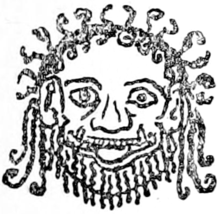is sufficiently demonstrated. In each of these urns the device is the same, a column and a tree on each side of the head. As to the meaning of these horns, their survival as very powerful prophylactics justifies the assumption that they were then, as now, used to strengthen or reinforce the power supposed to belong to the head of the Medusa.
I would remark en passant upon the remarkable appendages beneath the chin in this example, and also in the others above referred to. These are certainly not snakes; neither are they female hair, of which there is an abundance of the ordinary sort twisted, it may be, to indicate snakes. I ask attention to this particular as bearing on
 Fig. 13. |
 Fig. 14. |
my main thesis, and I submit they are intended to indicate a beard. Many illustrations of bearded Medusæ are given by Six,[1] proving the Gorgon to have been male as well as female. Of these I will at present only reproduce one example (Fig. 13) from Six, De Gorgone, Tab. I. In addition to the unmistakable beard, I ask attention to the no less instructive curls, which are anything but snake-like.
My next example (Fig. 14) is from a large terracotta plaque, measuring some 16 inches in diameter, now
- ↑ Specimen literarium inaugurale de Gorgone, &c, J. Six, 4to, Amstelodami, 1885.
